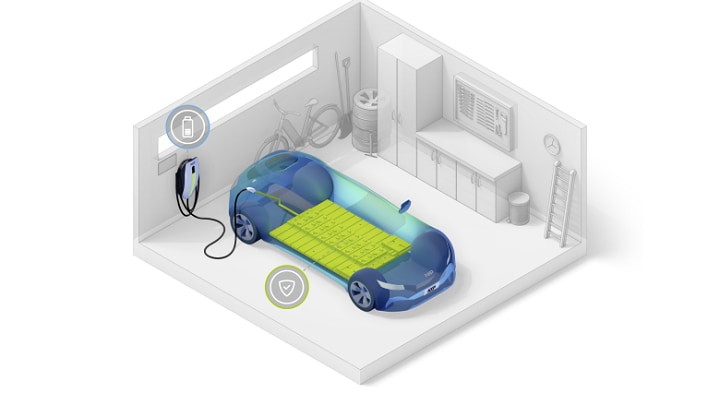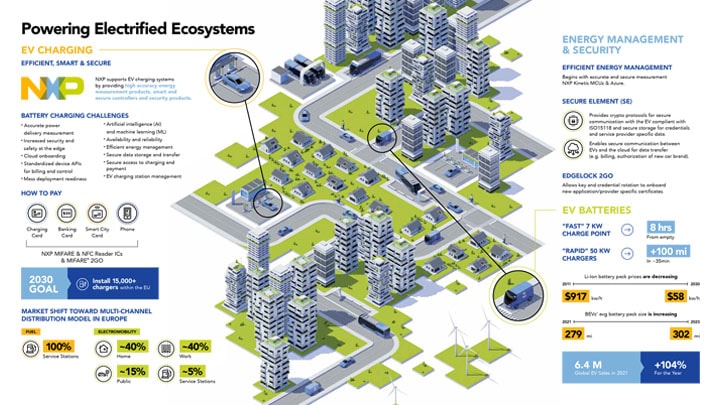The automotive sector has evolved dramatically over the centuries. From the
first “Motorwagen” in 1886 to the latest alternative power vehicle in 2022,
the automotive industry has also exploded in growth – to the tune of about
$2.8 trillion globally – despite a global pandemic.
In fact, it is the global pandemic, as well as other factors, such as
regulations, consumer behavior and technology, that are driving the growth of
electrification, specifically, in the automotive industry now and in the years
to come.
There have been a number of things in the electrification market in particular
that have delivered on its explosiveness in the past few years. First, to make
sure that electric mobility adoption is widespread and rapid, it is imperative
that new electric vehicles (EVs) are launched in the market at a relatively
quick pace. To build on that momentum, the entire mobility ecosystem must work
in sync to make the move towards electrification successful – from EV
manufacturers and suppliers to dealers, financers, energy providers, charging
station operators and beyond.
From all of this, there are some notable trends that have emerged in the
electrification market for 2022:
More Tech-Savvy EVs Being Produced
Some twenty years into the 21st century, it should come as no
surprise that automakers continue to integrate more digital technology into
the vehicles that they roll out of their manufacturing plants. Add to that mix
tech companies, such as Tesla and Google, who are also working on – and
delivering – electric and self-driving vehicles themselves. All of this points
to an automotive evolution in 2022 and beyond of vehicles being produced full
of technology, addressing a plethora of digital touchpoints. This leads to
aggressive competition to quickly develop the digital, software and electronic
operating systems to power and control highly advanced, zero-emission EVs,
which will be loaded with digital technology.
 Advanced EVs will help to increase sustainability and limit environmental
impact.
Advanced EVs will help to increase sustainability and limit environmental
impact.
Collaboration Between Automakers and Technology Companies
As quickly as the latest digital technology is being integrated into new
vehicles, it should come as no surprise to see the natural forming of
partnerships between automakers and technology companies. Automakers know that
it takes an exponential amount of specialized software and advanced technology
to get electric, connected and autonomous vehicles to function safely and
correctly. That leaves them two choices: either make enormous investments in
their Research and Technology divisions or join in a partnership with tech
companies that can do the work for them by designing and producing new
operating systems that these technologically advanced, next-generation
vehicles will need.
Taking EV Home Charging to The Next Level
For EV owners, Level 1 charging for EVs has always been an available option at
home, since this method requires the driver to plug their vehicle into a
traditional outlet. For urban use, you could get 30-50 miles from a single
overnight charge. As a result, more and more EV drivers are opting for home
charging as an alternative to using public stations.
However, Level 2 chargers, which could fully charge the EV overnight, are
gaining popularity in large part to incentives from states and utility
companies, as well as EV manufacturers who are also helping with its
acceptance. As a result, the
global EV charger market is expected to grow at a 28.5% CAGR
between 2021 and 2028.
 Level 2 chargers will bring faster charging into the home, leading to
accelerated market growth.
Level 2 chargers will bring faster charging into the home, leading to
accelerated market growth.
Want to learn more about EV Charging Development? Check out
our latest
whitepaper.
Increasing Local Battery Production
There has been increasing attention to the total carbon footprint of vehicles since 2021. It is not surprising to see that China produced almost
80% of global lithium-ion battery supplies. This is up 3% from the previous year.
Add to this the need to ship these batteries globally and it becomes apparent
that this is a detrimental factor to the carbon footprint of EEVs. So, it is
essential and welcome news to receive announcements of local battery
gigafactories being built by the likes of Tesla, Stellantis and Volkswagen
Group in other countries, especially considering that they need these raw
materials as well. To that end, you have Cornish Lithium and British Lithium
focusing their efforts on Cornwall for its potential lithium supply, while
Vulcan Energy Resources is hoping to uncover huge lithium deposits in the
Upper Rhine Valley of Germany. Ultimately, there needs to be as much local
production as possible, with batteries and their essential elements at the top
of the list, if EVs are going to be considered “truly green.”
Batteries Are the Key
When you think of batteries, the first thing that may spring to mind might be
the common batteries that are used in ordinary devices, such as TV remotes,
game controllers or other devices. However, EV batteries are a different story
altogether. They are intricate, intelligent technologies with semiconductors
playing a critical part in how they operate. If these types of batteries are
managed to the best of their capabilities, then EVs will go farther on a
single charge effortlessly. That is why EV batteries are key to the start of
an e-revolution in the automotive industry, in that they directly affect the
functionality and driving range as a fuel source. They also influence the
overall consumer adoption and satisfaction of EVs in the automotive market.
For example, there are
battery management systems (BMS) which include integrated circuits (ICs) and sensors that control
crucial characteristics, such as current, voltage and temperatures. As a
result, a BMS is able to accomplish three important things – make the most of
a battery’s electrical output, balance its functions and help ensure it
operates safely. It is no wonder that top EV makers are turning to technology
partners to help them achieve these efficiencies that BMS can deliver to EVs.
In fact, in 2021, two out of the top three EV makers selected NXP BMS for
their solution. So it is easy to see that BMS is integral to the e-revolution
that is happening in the automotive industry.
The Future is Here
EVs are on the horizon. Actually, they are already here. In order for
electrification to fully take hold and gain momentum as the way we move around
as a society, more needs to be done. From decarbonizing the transport sector
to energy, infrastructure, mobility and automotive players taking the lead to
create roles for new jobs and industries worth billions. In addition, it will
be critical that economic viability and sustainability are weaved into the
latest innovative technology and properly guided as mobility is transformed.
Ultimately, all roads are pointing to an exciting future for the automotive
electrification market in the years to come.
 Download the
infographic
to see how NXP is contributing to the electrification revolution.
Download the
infographic
to see how NXP is contributing to the electrification revolution.
Want to learn more about how NXP is part of the e-revolution? Visit our
Electrification webpage.







